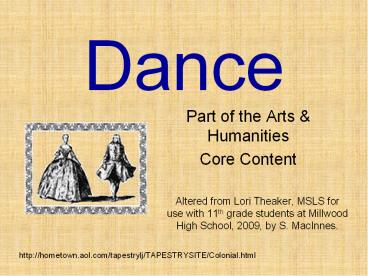Dance - PowerPoint PPT Presentation
1 / 22
Title:
Dance
Description:
Social trend (funk, hip-hop, line dancing), ballroom (waltz, foxtrot, tango, swing) ... What is a ballroom dance that came from folk dance? The waltz ... – PowerPoint PPT presentation
Number of Views:11953
Avg rating:5.0/5.0
Title: Dance
1
Dance
- Part of the Arts Humanities
- Core Content
Altered from Lori Theaker, MSLS for use with 11th
grade students at Millwood High School, 2009, by
S. MacInnes.
http//hometown.aol.com/tapestrylj/TAPESTRYSITE/Co
lonial.html
2
True or FalseDance is always done to
music.You need a partner to dance.The first
ballet dancers were men.To dance, you need
special training and you have to be thin.
3
Dance and Movement
- What is the difference between everyday movements
and dance? - When does movement become dance?
- Movement becomes dance when the elements of dance
(space, time, and force) are intentionally
incorporated.
AH-E-2.1.31, AH-M-2.1.33
4
SPACE
- Pathways - curved lines, straight lines, zigzags,
circles, figure-eights, and many more - Focus the direction the body is facing, eye
focus direction - Shape - large, small, rounded, and angular
- Level - high, medium, low or on the floor
- Direction - forward, backwards, diagonally,
sideways - AH-E-2.1.31, 1.15, 2.23
5
TIME
- TEMPO - fast, slow, moderate, accelerating,
decelerating - DURATION - short, long
- BEAT - pulse of the music
- AH-E-2.1.31, 1.15, 2.23
6
Dynamics
- How is the body moving?
- Energy strong, light, tense, relaxed
- Flow sustained, suspended, lyrical, staccato.
Relationship
- With whom or what is the body moving?
- Grouping apart, connected, solo, duet, ensemble
formation. - Dancer relationship side-by-side, near, far,
role-relationship. - Interactions leading, following, mirroring,
unison, contrast, meeting, parting, reaction.
7
FORCEthe use of energy while moving
- QUALITY smooth, sharp, round,
- free, flowing
- ENERGY weak, strong
- WEIGHT heavy, light, suspended
- collapsed
AH-E-2.1.31, 1.15, 2.23
8
All dance movements can be labeled as locomotor
or non-locomotor.
NON-LOCOMOTOR movements that do not change
location
LOCOMOTOR movements that travel
AH-E-2.1.31
9
Locomotor Movements
Dancers using locomotor movements may walk, run,
skip, hop, jump, slide, leap, or gallop. These
movements may be high (possibly indicating joy),
medium, or low (possibly indicating sadness.)
AH-E-2.1.31, 1.15, 2.23
10
Non-locomotor Movements
Dancers are using non-locomotor movements when
they stay in one place but bend, stretch, twist,
or swing their body.
11
How is a dance created?
- Dances are created by combining locomotor and
nonlocomotor movements. - A dance, like a book,
- has a beginning, a middle, and an end.
AH-M-2.1.34
12
Dance has 3 main forms
- ceremonial (religion, celebration, ritual)
- recreational (folk, social dancing, aerobic
dance) - artistic (ballet, modern, narrative, tap,
lyrical).
AH-E-2.2.32
13
Culture and Dance
- Nearly all cultures incorporate dance in some
way. - Dance is a major component of many cultures.
- Dance is often used to communicate or celebrate.
14
Some more about dance culture
- Cultures use dance in ways that are both social
and personal. - What are some examples of culture and dance you
can think of? How do those cultures use dance?
AH-E-2.2.33, A-HI-2.2.31, AH-M-2.2.32
15
Dance is also representative of time periods
- What time period do you think of when you hear
- Charleston,
- Virginia Reel,
- Swing,
- Disco,
- Break dancing, or
- Hip Hop?
- Something to think about
- How are the dances of these time periods related
to the politics of the time?
AH-H-2.3.31, AH-H-2.3.311
16
Dance in History
- Dance has played an important function in many
cultures throughout history. - Dance styles, costumes and music often reflect
the political climate of the time. - Dances such as the Locomotion, Macarena, and
even the Chicken Dance all perform a function
in our society they create a group of dancers
having fun! - AH-E-2.2.31, 1.15, 2.23, 2.25
17
Dance types
- Ethno-cultural singing games (hokey-pokey),
religion or ceremonial (aboriginal spirit dance),
folk (French-Canadian, step dance, Scottish
country dance), Classical (Chinese ribbon
dance). - Social trend (funk, hip-hop, line dancing),
ballroom (waltz, foxtrot, tango, swing) - Historical baroque, renaissance, minuet,
Charleston, twist, disco, lambada, hip-hop. - Modern creative (centers on a dancer's own
interpretations instead structured steps),
classical (Bausch, Graham devt of modern w/
technique), post-modern (everyday movt as art) - Theatrical tap, musical theatre, dance drama,
ice dance, ethno-cultural
18
Answer the following questions
- Who started folk dance?
- Ordinary people
- What is the main difference between folk and
popular dances? - Popular dances are usually popular for only a
short time. - What is a ballroom dance that came from folk
dance? - The waltz
- Why did a lot of new dances come from the United
States? - The mixing of immigrant cultures produced new
forms of dance. - What type of dancing became popular in the
mid-1980s? - Breakdancing.
19
Is there anything else I should know?
Dance allows the dancer or choreographer to
communicate their ideas, thoughts, and feelings
through movement. These movements are structured
and repeatable, in that they can be taught to
others.
AH-E-2.1.14, 1.15, 2.22
20
Dance is often used to tell a story
Like a story or a book, each dance has a
beginning, middle and an end. Dance is made up
movement materials, connected into phrases
and put together into a complete dance.
AH-M-2.2.31, AH-2.2.32, AH-E.2.1.31
21
Speaking writing
- Form a group of 3 4. Discuss one of the
following dance forms with your partners and
write some descriptive words for that form.
- Classical ballet
- Waltz
- Jazz
- Break dance
- Disco
- Tango
- Latin ballroom
- Example
- Chinese folk dance
- Traditional
- Dragon dances
- Generation
- Festival occasions
- Lion dances
22
Bibliography
- Resources used for this presentation include
- KETs DanceSense,
- an original Power Point presentation created by
Anna W. Martin (sent to JCES staff by HSE Pam
Clemons) - Microsoft Office ClipArt files
- Nova Scotia Dance 11 curriculum guide, 1999































